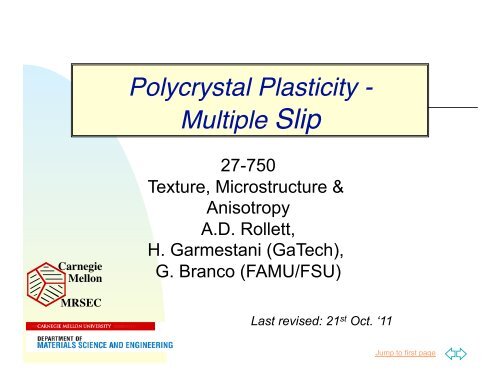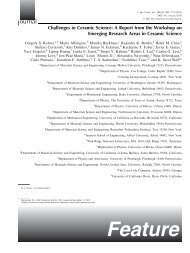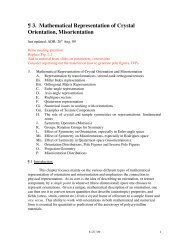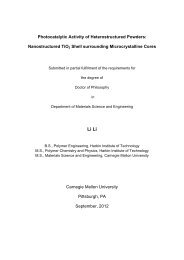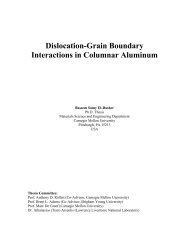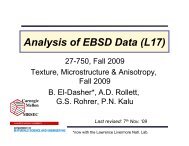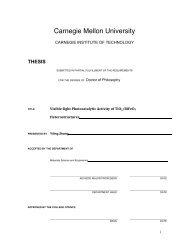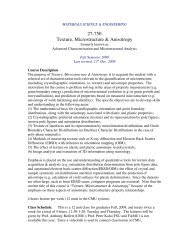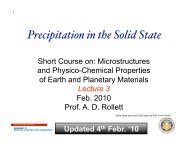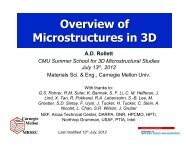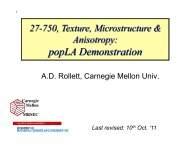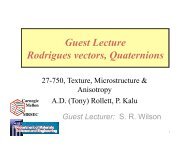Polycrystal Plasticity - Multiple Slip
Polycrystal Plasticity - Multiple Slip
Polycrystal Plasticity - Multiple Slip
You also want an ePaper? Increase the reach of your titles
YUMPU automatically turns print PDFs into web optimized ePapers that Google loves.
Carnegie<br />
Mellon<br />
MRSEC<br />
1<br />
<strong>Polycrystal</strong> <strong>Plasticity</strong> - <br />
<strong>Multiple</strong> <strong>Slip</strong>"<br />
27-750<br />
Texture, Microstructure &<br />
Anisotropy<br />
A.D. Rollett,<br />
H. Garmestani (GaTech),<br />
G. Branco (FAMU/FSU)<br />
Last revised: 21 st Oct. ‘11<br />
Jump to first page
2<br />
Objective"<br />
The objective of this lecture is to show how<br />
plastic deformation in polycrystals requires<br />
multiple slip in each grain.<br />
Further, to show how to calculate the<br />
distribution of slips in each grain of a<br />
polycrystal (principles of operation of Los<br />
Alamos polycrystal plasticity, LApp).<br />
Requirements:<br />
Dislocation controlled plastic strain<br />
Mechanics of Materials<br />
Continuum Mechanics
3<br />
Questions"<br />
What is the difference between single slip and multiple slip in terms of<br />
boundary conditions?<br />
What is “deviatoric stress” and why does it have 5 components?<br />
How does the von Mises criterion for ductility relate to the 5 components of<br />
deviatoric stress and strain?<br />
How does the Bishop-Hill theory work? What is the input and output to the<br />
algorithm? What is meant by the “maximum work” principle?<br />
What is the Taylor factor (both definition and physical meaning)?<br />
Why is the rate-sensitive formulation for multiple slip useful above and<br />
beyond what the Bishop-Hill approach gives?<br />
What is it that causes/controls texture development?<br />
On what quantities is lattice reorientation based (during multiple slip)?<br />
How can we compute the macroscopic strain due to any given slip system?<br />
How can we compute the resolved shear stress on a given slip system,<br />
starting with the macroscopic stress (tensor)?<br />
What does Bishop & Hill state of stress mean (what is the physical<br />
meaning)? [Each B&H stress state (one of the 28) corresponds to a corner<br />
of the single xtal yield surface that activates either 6 or 8 slip systems<br />
simultaeneously]
4<br />
References"<br />
Kocks, Tomé & Wenk: Texture & Anisotropy (Cambridge); chapter<br />
8, 1996. Detailed analysis of plastic deformation and texture<br />
development.<br />
Reid: Deformation Geometry for Materials Scientists, 1973. Older<br />
text with many nice worked examples. Be careful of his examples<br />
of calculation of Taylor factor because, like Bunge & others, he<br />
does not use von Mises equivalent stress/strain to obtain a scalar<br />
value from a multiaxial stress/strain state.<br />
Hosford: The Mechanics of Crystals and Textured <strong>Polycrystal</strong>s,<br />
1993 (Oxford). Written from the perspective of a mechanical<br />
metallurgist with decades of experimental and analytical experience<br />
in the area.<br />
Khan & Huang: Continuum Theory of <strong>Plasticity</strong>. Written from the<br />
perspective of continuum mechanics.<br />
De Souza Neto, Peric & Owen: Computational Methods for<br />
<strong>Plasticity</strong>, 2008 (Wiley). Written from the perspective of continuum<br />
mechanics.<br />
Key Papers: Taylor G., (1938) Plastic strain in metals, J. Inst.<br />
Metals (U.K.) 62 307 ; Bishop J and Hill R (1951) Phil. Mag. 42<br />
1298.
5<br />
Output of LApp"<br />
Figure shows pole<br />
figures for a simulation<br />
of the development of<br />
rolling texture in an fcc<br />
metal.<br />
Top = 0.25 von Mises<br />
equivalent strain; 0.50,<br />
0.75, 1.50 (bottom).<br />
Note the increasing<br />
texture strength as the<br />
strain level increases.<br />
Increasing strain
6<br />
The Theory depends upon:<br />
Basic Considerations"<br />
The physics of single crystal plastic deformation;<br />
relations between macroscopic and microscopic quantities<br />
( strain, stress ...);<br />
The mathematical representation and models<br />
Initially proposed by Sachs (1928), Cox and Sopwith (1937),<br />
and Taylor in 1938. Elaborated by Bishop and Hill (1951).<br />
Self-Consistent model by Kröner (1958, 1961), extended by<br />
Budiansky and Wu (1962).<br />
Further developments by Hill (1965a,b) and Lin (1966, 1974,<br />
1984) and others.<br />
• Read Taylor (1938) “Plastic strain in metals.” J. Inst. Metals (U.K.) 62, 307. - available<br />
as: Taylor.1938.pdf
7<br />
Basic Considerations"<br />
Sachs Model (previous lecture on single crystal):<br />
- All single-crystal grains with aggregate or polycrystal<br />
experience the same state of stress;<br />
- Equilibrium condition across the grain boundaries satisfied;<br />
- Compatibility conditions between the grains violated, thus,<br />
finite strains will lead to gaps and overlaps between grains;<br />
- Generally most successful for single crystal deformation with<br />
stress boundary conditions on each grain.<br />
Taylor Model (this lecture):<br />
- All single-crystal grains within the aggregate experience the<br />
same state of deformation (strain);<br />
- Equilibrium condition across the grain boundaries violated,<br />
because the vertex stress states required to activate multiple slip<br />
in each grain vary from grain to grain;<br />
- Compatibility conditions between the grains satisfied;<br />
- Generally most successful for polycrystals with strain<br />
boundary conditions on each grain.
8<br />
Sachs versus Taylor"<br />
Diagrams illustrate<br />
the difference<br />
between the Sachs<br />
iso-stress<br />
assumption of<br />
single slip in each<br />
grain (a, c and e)<br />
versus the Taylor<br />
assumption of isostrain<br />
with multiple<br />
slip in each grain (b,<br />
d).<br />
iso-stress iso-strain
9<br />
Sachs versus Taylor: <br />
Single versus <strong>Multiple</strong> <strong>Slip</strong>"<br />
External Stress or External Strain<br />
Increasing strain<br />
σ ˙<br />
=<br />
τ γ<br />
˙ ε =<br />
1<br />
cosλcosφ<br />
Small arrows<br />
indicate identical<br />
stress state in<br />
each grain<br />
Each grain<br />
deforms according<br />
to which single<br />
slip system is<br />
active<br />
D = E T dγ<br />
Small arrows<br />
indicate variable<br />
stress state in<br />
each grain<br />
<strong>Multiple</strong> slip (with 5<br />
or more systems) in<br />
each grain satisfies<br />
the externally<br />
imposed strain, D
10<br />
Taylorʼs <strong>Multiple</strong> <strong>Slip</strong>"<br />
Shows how each grain must conform to the macroscopic<br />
strain imposed on the polycrystal
11<br />
Example of <strong>Slip</strong> Lines at Surface <br />
(plane strain stretched Al 6022)"<br />
T-Sample at 15% strain<br />
PD // TD<br />
PSD // RD<br />
Note how each grain<br />
exhibits varying degrees<br />
of slip line markings.<br />
Although any given<br />
grain has one dominant<br />
slip line (trace of a slip<br />
plane), more than one is<br />
generally present.<br />
Taken from PhD<br />
research of Yoon-Suk<br />
Choi on surface<br />
roughness development<br />
in Al 6022
12<br />
Notation: 1"<br />
Strain, local: E local ; global: E global<br />
<strong>Slip</strong> direction (unit vector): b or s<br />
<strong>Slip</strong> plane (unit) normal: n<br />
<strong>Slip</strong> tensor, m ij = b i n j<br />
Stress (tensor or vector): σ<br />
Shear stress (usually on a slip system): τ<br />
Shear strain (usually on a slip system): γ<br />
Stress deviator (tensor): S<br />
Rate sensitivity exponent: n<br />
<strong>Slip</strong> system index: s or α<br />
Note that when an index (e.g. of a <strong>Slip</strong> system, b (s) n (s) ) is<br />
enclosed in parentheses, it means that the summation<br />
convention does not apply even if the index is repeated in the<br />
equation.
13<br />
Notation: 2"<br />
Coordinates: current: x; reference X<br />
Velocity of a point: v.<br />
Displacement: u<br />
Hardening coefficient: h (dσ = h dγ )<br />
Strain, ε<br />
measures the change in shape<br />
Work increment: dW<br />
do not confuse with spin!<br />
Infinitesimal rotation tensor: Ω<br />
Elastic Stiffness Tensor (4th rank): C
14<br />
Plastic spin: W<br />
Notation: 3"<br />
measures the rotation rate; more than one<br />
kind of spin is used:<br />
“Rigid body” spin of the whole polycrystal: W<br />
“grain spin” of the grain axes (e.g. in<br />
torsion): W g<br />
“lattice spin” from slip/twinning (skew<br />
symmetric part of the strain): W c .<br />
Rotation (small): ω
15<br />
Notation: 4"<br />
Deformation gradient: F<br />
Measures the total change in shape<br />
(rotations included).<br />
Velocity gradient: L<br />
Tensor, measures the rate of change of the<br />
deformation gradient<br />
Time: t<br />
Strain rate: D<br />
symmetric tensor; D = symm(L)<br />
€<br />
≡ ˙ ε ≡ dε<br />
dt<br />
€<br />
F ij = ∂x i<br />
∂X j
16<br />
Dislocations and Plastic Flow"<br />
At room temperature the dominant mechanism of plastic deformation<br />
is dislocation motion through the crystal lattice.<br />
Dislocation glide occurs on certain crystal planes (slip planes) in<br />
certain crystallographic directions (// Burgers vector).<br />
A slip system is a combination of a slip direction and slip plane<br />
normal.<br />
A second-rank tensor (m ij = b i n j ) can associated with each slip<br />
system, formed from the outer product of slip direction and normal.<br />
The resolved shear stress on a slip system is then given by τ = m ij σ ij .<br />
The crystal structure of metals is not altered by the plastic flow.
17<br />
Schmidʼs Law"<br />
Initial yield stress varies from sample to sample depending on, among<br />
several factors, the relation between the crystal lattice to the loading axis<br />
(i.e. orientation, written as g).<br />
The applied stress resolved along the slip direction on the slip plane (to<br />
give a shear stress) initiates and controls the extent of plastic deformation.<br />
Yield begins on a given slip system when the shear stress on this system<br />
reaches a critical value, called the critical resolved shear stress (crss),<br />
independent of the tensile stress or any other normal stress on the lattice<br />
plane (in less symmetric lattices, however, there may be some dependence<br />
on the hydrostatic stress).<br />
The magnitude of the yield stress depends on the density and arrangement<br />
of obstacles to dislocation flow, such as precipitates (not discussed here).<br />
Definition of slip plane, direction and systems<br />
continued
18<br />
Crystallography of <strong>Slip</strong>"<br />
<strong>Slip</strong> occurs most readily in specific directions on certain<br />
crystallographic planes.<br />
<strong>Slip</strong> plane – is the plane of greatest atomic density.<br />
<strong>Slip</strong> direction – is the close-packed direction within the slip plane.<br />
<strong>Slip</strong> system – is the combination of preferred slip planes and slip<br />
directions (on those specific planes) along which dislocation motion<br />
occurs. <strong>Slip</strong> systems are dependent on the crystal structure.
19<br />
Crystallography of <strong>Slip</strong> in fcc"<br />
Example: Determine the slip system for the (111) plane in a fcc<br />
crystal and sketch the result.<br />
The slip direction in fcc is <br />
The proof that a slip direction [uvw]<br />
lies in the slip plane (hkl) is given by<br />
calculating the scalar product:<br />
hu + kv + lw =0
20<br />
<strong>Slip</strong> Systems in fcc, bcc, hcp"<br />
The slip systems for FCC, BCC and HCP crystals are<br />
For this lecture we will focus on FCC crystals only<br />
Note:<br />
In the case of FCC crystals we can see in the table that there are 12 slip<br />
systems. However if forward and reverse systems are treated as<br />
independent, there are then 24 slip systems.
21<br />
Elastic vs. Plastic Deformation"<br />
Selection of <strong>Slip</strong> Systems for Rigid-Plastic Models<br />
Assumption – For FPD, the elastic deformation rate is<br />
usually small when compared to the plastic deformation<br />
rate and thus it can be neglected.<br />
Reasons:<br />
The elastic<br />
deformation is<br />
confined to the<br />
ratio of stress to<br />
elastic modulus<br />
Perfect plastic materials -<br />
equivalent stress = initial<br />
yield stress<br />
For most metals – initial<br />
yield stress is 2 or 3 orders<br />
of magnitude less than the<br />
elastic modulus –<br />
ratio is
22<br />
Determination of <strong>Slip</strong> Systems"<br />
Selection of <strong>Slip</strong> Systems for Rigid-Plastic Models<br />
Once the elastic deformation rate is considered, it is<br />
reasonable to model the material behavior using the<br />
rigid-plastic model given by:<br />
D = D p = m α<br />
n<br />
∑ ˙<br />
α=1<br />
where<br />
n is ≤ to 12 systems (or 24 systems – forward and reverse )<br />
considered independent<br />
Note: D can expressed by six components ( Symmetric Tensor)<br />
Because of the condition - tr(D) = Dii = 0<br />
, only five out of<br />
€ the six components are independent.<br />
€<br />
γ α
23<br />
Von Mises criterion"<br />
Selection of <strong>Slip</strong> Systems for Rigid <strong>Plasticity</strong> Models<br />
As a consequence of the condition<br />
tr(D) = Dii<br />
=<br />
the number of possible active slip systems (in cubic metals) is greater<br />
than the number of independent components of the tensor strain rate<br />
D p , from the mathematical point of view (under-determined system), so<br />
any combination of five slip systems that satisfy the incompressibility<br />
condition can allow the prescribed deformation to take place. The<br />
requirement that at least five independent systems are required for<br />
plastic deformation is known as the von Mises Criterion. If less than 5<br />
independent slip systems are available, the ductility is predicted to be<br />
low in the material. The reason is that each grain will not be able to<br />
deform with the body and gaps will open up, i.e. it will crack. Caution:<br />
even if a material has 5 or more independent systems, it may still be<br />
brittle (e.g. Iridium).<br />
0
24<br />
Minimum Work Principle"<br />
Proposed by Taylor in (1938).<br />
The objective is to determine the combination of shears or slips that<br />
will occur when a prescribed strain is produced.<br />
States that, of all possible combinations of the 12 shears that can<br />
produce the assigned strain, only that combination for which the<br />
energy dissipation is the least is operative.<br />
The defect in the approach is that it says nothing about the activity or<br />
resolved stress on other, non-active systems (This last point was<br />
addressed by Bishop and Hill in 1951).<br />
Mathematical n<br />
statement: τ c<br />
∑ ˙<br />
α=1<br />
Bishop J and Hill R (1951) Phil. Mag. 42 1298<br />
n<br />
∑ *<br />
˙ γ<br />
*<br />
α<br />
α=1<br />
γ α ≤ τ α<br />
To be continued
25<br />
Minimum Work Principle<br />
Here,<br />
˙<br />
γ - are the actually activated slips that produce D.<br />
α<br />
*<br />
˙ γ α - is any set of slips that satisfy tr(D)=Dii = 0, but are operated by the<br />
corresponding stress satisfying the loading/unloading criteria.<br />
τ c<br />
€<br />
Minimum Work Principle"<br />
n<br />
∑τ ˙ γ ≤ τ<br />
*<br />
c α α<br />
α=1<br />
α=1<br />
- is the (current) critical resolved shear stress (crss) for the material<br />
(applies on any of the αth activated slip systems).<br />
- is the current shear strength of (= resolved shear stress on) the αth τ<br />
*<br />
α<br />
geometrically possible slip system that may not be compatible with the<br />
externally applied stress.<br />
n<br />
∑ ˙<br />
γ<br />
*<br />
α
26<br />
€<br />
Recall that in the Taylor model all the slip systems are<br />
assumed to harden at the same rate, which means that<br />
and then,<br />
€<br />
Minimum Work Principle"<br />
n<br />
τ = τ<br />
*<br />
c α<br />
˙ γ α ∑ ≤ ˙<br />
α=1<br />
n<br />
∑<br />
α=1<br />
γ<br />
*<br />
α<br />
Note that, now, we have only 12 operative slip systems once<br />
the forward and reverse shear strengths (crss) are<br />
considered to be the same in absolute value.
27<br />
Minimum Work Principle"<br />
n<br />
˙ γ α ∑ ≤ ˙<br />
α=1<br />
n<br />
∑<br />
α=1<br />
γ<br />
*<br />
α<br />
Thus Taylor’s minimum work criterion can be summarized<br />
as in the following: Of the possible 12 slip systems,<br />
only that combination for which the sum of the<br />
€ absolute values of shears is the least is the<br />
combination that is actually operative!<br />
The uniformity of the crss means that the minimum work<br />
principle is equivalent to a minimum microscopic shear<br />
principle.
28<br />
Stress > CRSS?"<br />
The obvious question is, if we can find a<br />
set of microscopic shear rates that satisfy<br />
the imposed strain, how can we be sure<br />
that the shear stress on the other, inactive<br />
systems is not greater than the critical<br />
resolved shear stress?<br />
This is not the same question as that of<br />
equivalence between the minimum work<br />
principle and the maximum work approach<br />
described later in this lecture.
29<br />
Stress > CRSS?"<br />
The work increment is the (inner) product of the<br />
stress and strain tensors, and must be the same,<br />
regardless of whether it is calculated from the<br />
macroscopic quantities or the microscopic quantities:<br />
For the actual set of shears in the material, we can<br />
write (omitting the “*”),<br />
where the crss is outside the sum because it is<br />
constant.<br />
[Reid: pp 154-156]
30<br />
Stress > CRSS?"<br />
Now we know that the shear stresses on<br />
the hypothetical (denoted by “*”) set of<br />
systems must be less than or equal to the<br />
crss, τ c , for all systems, so:<br />
This means that we can write:
31<br />
Stress > CRSS?"<br />
However the LHS of this equation is equal<br />
to the work increment for any possible<br />
combination of slips, δw=σ ijδε ij which is<br />
equal to τ c Σ αδγ α , leaving us with:<br />
So dividing both sides by τc allows us to<br />
write:<br />
∑δγ ≤ δγ *<br />
α<br />
∑ Q.E.D.<br />
α
€<br />
32<br />
Under stress boundary conditions, single slip occurs<br />
Uniaxial Tension or Compression:<br />
˙<br />
ε = P ⋅ D⋅ P<br />
The (dislocation) slip is given by<br />
˙<br />
γ =<br />
Minimum Work, Single <strong>Slip</strong>"<br />
˙<br />
ε<br />
cosλcosφ<br />
˙ ε<br />
=<br />
m<br />
= b,<br />
or, s<br />
P is a unit vector in the<br />
loading direction<br />
This slide, and the next one, are a re-cap of the lecture<br />
on single slip<br />
= n
€<br />
33<br />
Minimum Work, Single <strong>Slip</strong>"<br />
Applying the Minimum Work Principle, it follows that<br />
σ<br />
τ<br />
˙ γ<br />
=<br />
˙ ε =<br />
σ = τ(γ)<br />
m<br />
1<br />
cosλcosφ<br />
= τ(ε m)<br />
m<br />
= 1<br />
m<br />
Note: τ(γ) describes the dependence of the critical resolved shear<br />
stress (crss) on strain (or slip curve), based on the idea that the<br />
crss increases with increasing strain. The Schmid factor is equal<br />
to m and the maximum value is equal to 0.5.
34<br />
Deformation rate is multi-axial<br />
General case – D<br />
Only five independent (deviatoric)<br />
Crystal - FCC<br />
γ γ a2<br />
<strong>Multiple</strong> <strong>Slip</strong>"<br />
<strong>Slip</strong> rates - a1,<br />
, γ ...., a3<br />
on the slips a1 , a2 , a3 ...,<br />
respectively.<br />
€<br />
components<br />
[ 101]<br />
Note correction to system b2
35<br />
2<br />
€<br />
2<br />
2<br />
Using<br />
the following set of relations can be obtained<br />
6D<br />
6D<br />
6D<br />
xy<br />
yz<br />
zx<br />
=<br />
=<br />
=<br />
2<br />
2<br />
2<br />
6e<br />
6e<br />
6e<br />
x<br />
y<br />
z<br />
⋅ D ⋅e<br />
⋅ D ⋅e<br />
⋅ D ⋅e<br />
<strong>Multiple</strong> <strong>Slip</strong>"<br />
D = D p = P α<br />
y<br />
z<br />
y<br />
= -γ<br />
= -γ<br />
= -γ<br />
a1<br />
a2<br />
a3<br />
+ γ<br />
+ γ<br />
+ γ<br />
a2<br />
a3<br />
a1<br />
−γ<br />
+ γ<br />
+ γ<br />
b1<br />
b2<br />
b3<br />
+ γ<br />
−γ<br />
−γ<br />
b2<br />
b3<br />
b1<br />
+ γ<br />
−γ<br />
+ γ<br />
Note: e x , e y , e z are unit vectors parallel to the axes<br />
n<br />
∑ ˙<br />
α=1<br />
γ α<br />
c1<br />
c2<br />
c3<br />
−γ<br />
+ γ<br />
−γ<br />
TO BE CONTINUED<br />
c2<br />
c3<br />
c1<br />
+ γ<br />
+ γ<br />
−γ<br />
d1<br />
d2<br />
d3<br />
−γ<br />
−γ<br />
+ γ<br />
d2<br />
d3<br />
d1
36<br />
=<br />
6<br />
6<br />
=<br />
6<br />
6<br />
=<br />
6<br />
6<br />
d2<br />
d1<br />
c2<br />
c1<br />
b2<br />
b1<br />
a2<br />
a1<br />
d1<br />
d3<br />
c1<br />
c3<br />
b1<br />
b3<br />
a1<br />
a3<br />
d3<br />
d2<br />
c3<br />
c2<br />
b3<br />
b2<br />
a3<br />
a2<br />
γ<br />
γ<br />
γ<br />
γ<br />
γ<br />
γ<br />
γ<br />
γ<br />
γ<br />
γ<br />
γ<br />
γ<br />
γ<br />
γ<br />
γ<br />
γ<br />
γ<br />
γ<br />
γ<br />
γ<br />
γ<br />
γ<br />
γ<br />
γ<br />
<br />
<br />
<br />
<br />
<br />
<br />
<br />
<br />
<br />
<br />
<br />
<br />
<br />
<br />
<br />
<br />
<br />
<br />
<br />
<br />
<br />
<br />
<br />
<br />
−<br />
+<br />
−<br />
+<br />
−<br />
+<br />
−<br />
⋅<br />
⋅<br />
=<br />
−<br />
+<br />
−<br />
+<br />
−<br />
+<br />
−<br />
⋅<br />
⋅<br />
=<br />
−<br />
+<br />
−<br />
+<br />
−<br />
+<br />
−<br />
⋅<br />
⋅<br />
=<br />
z<br />
z<br />
zz<br />
y<br />
y<br />
yy<br />
x<br />
x<br />
xx<br />
e<br />
D<br />
e<br />
D<br />
e<br />
D<br />
e<br />
D<br />
e<br />
D<br />
e<br />
D<br />
<strong>Multiple</strong> <strong>Slip</strong>"
37<br />
To verify these relations, consider the contribution of<br />
shear on system c3 as an example:<br />
γ<br />
Given :<br />
<strong>Slip</strong> system - c 3; c3<br />
Unit vector in the slip direction – n =<br />
€<br />
1<br />
3 (-1,1,1)<br />
Unit normal vector to the slip plane – b =<br />
1<br />
(1,1,0)<br />
2<br />
The contribution of the c 3 system is given by<br />
1 c3<br />
c3 =<br />
( bn + nb)<br />
γ<br />
2<br />
<strong>Multiple</strong> <strong>Slip</strong>"<br />
γ<br />
2<br />
6<br />
⎡⎡− 2<br />
⎢⎢<br />
⎢⎢<br />
0<br />
⎢⎢⎣⎣<br />
1<br />
0<br />
2<br />
1<br />
1⎤⎤<br />
1<br />
⎥⎥<br />
⎥⎥<br />
0⎥⎥⎦⎦
38<br />
<strong>Multiple</strong> <strong>Slip</strong>"<br />
From the set of equations, one can obtain 6 relations between<br />
the components of D and the 12 shear rates on the 12 slip<br />
systems. By taking account of the incompressibility condition,<br />
this reduces to only 5 independent relations that can be<br />
obtained from the equations.<br />
So, the main task is to determine which combination of 5<br />
independent shear rates, out of 12 possible rates, should be<br />
chosen as the solution of a prescribed deformation rate D.<br />
This set of shear rates must satisfy Taylor’s minimum shear<br />
principle.<br />
Note : There are 792 sets or 12 C 5 combinations, of 5 shears, but only 96 are<br />
independent. Taylor’s minimum shear principle does not ensure that there is a unique<br />
solution (a unique set of 5 shears).
39<br />
<strong>Multiple</strong> <strong>Slip</strong>: Strain"<br />
Suppose that we have 5 slip systems that<br />
are providing the external slip, D.<br />
Let’s make a vector, D i , of the (external)<br />
strain tensor components and write down a<br />
set of equations for the components in<br />
terms of the microscopic shear rates, dγ α .<br />
Set D 2 = dε 22 , D 3 = dε 33 , D 6 = dε 12 ,<br />
D 5 = dε 13 , and D 4 = dε 23 .<br />
D_2& = [m_{22}^{(1) } & m_{22}^{(2)} & m_{22}^{(3)} & m_{22}^{(4)} & m_{22}^{(5)} ] \cdot [ d\gamma_1& \\ d\gamma_2& \\ d\gamma_3& \\ d\gamma_4& \\ d\gamma_5& ]
40<br />
<strong>Multiple</strong> <strong>Slip</strong>: Strain"<br />
This notation can obviously be simplified and all<br />
five components included by writing it in tabular or<br />
matrix form (where the slip system indices are<br />
preserved as superscripts in the 5x5 matrix):<br />
or, D = E T dγ<br />
\begin{bmatrix} D_2& \\ D_3& \\ D_4& \\ D_5& \\ D_6& \end{bmatrix} = \begin{bmatrix} m_{22}^{(1) } & m_{22}^{(2)} & m_{22}^{(3)} & m_{22}^{(4)} & m_{22}^{(5)} \\ m_{33}^{(1)} & m_{33}^{(2)} & m_{33}^{(3)} & m_<br />
{33}^{(4)} & m_{33}^{(5)} \\ (m_{23}^{(1)}+m_{32}^{(1)}) & (m_{23}^{(2)}+m_{32}^{(2)}) & (m_{23}^{(3)}+m_{32}^{(3)}) & (m_{23}^{(4)}+m_{32}^{(4)}) & (m_{23}^{(5)}+m_{32}^{(5)}) \\ (m_{13}^{(1)}+m_{31}^{(1)})<br />
& (m_{13}^{(2)}+m_{31}^{(2)}) & (m_{13}^{(3)}+m_{31}^{(3)}) & (m_{13}^{(4)}+m_{31}^{(4)}) & (m_{13}^{(5)}+m_{31}^{(5)}) \\ (m_{12}^{(1)}+m_{21}^{(1)}) & (m_{12}^{(2)}+m_{21}^{(2)}) & (m_{12}^{(3)}+m_{21}^<br />
{(3)}) & (m_{12}^{(4)}+m_{21}^{(4)}) & (m_{12}^{(5)} +m_{21}^{(5)})\end{bmatrix} \begin{bmatrix} d\gamma_1& \\ d\gamma_2& \\ d\gamma_3& \\ d\gamma_4& \\ d\gamma_5& \end{bmatrix}
41<br />
<strong>Multiple</strong> <strong>Slip</strong>: Stress"<br />
We can perform the equivalent analysis for<br />
stress: just as we can form an external<br />
strain component as the sum over the<br />
contributions from the individual slip rates,<br />
so too we can form the resolved shear<br />
stress as the sum over all the contributions<br />
from the external stress components (note<br />
the inversion of the relationship):<br />
Or,
42<br />
<strong>Multiple</strong> <strong>Slip</strong>: Stress"<br />
Putting into 5x6 matrix form, as for the<br />
strain components, yields:
43<br />
Definitions of Stress states,<br />
slip systems"<br />
Now define a set of six deviatoric stress terms, since<br />
we know that the hydrostatic component is irrelevant,<br />
of which we will actually use only 5:<br />
A:= (σ 22 - σ 33 ) F:= σ 23<br />
B:= (σ 33 - σ 11 ) G:= σ 13<br />
C:= (σ 11 - σ 22 ) H:= σ 12<br />
<strong>Slip</strong> systems (as before):<br />
Note: these systems have<br />
the negatives of the slip<br />
directions compared to those<br />
shown in the lecture on<br />
Single <strong>Slip</strong> (taken from<br />
Khans’ book), except for b2.<br />
Kocks: UQ -UK UP -PK -PQ PU -QU -QP -QK -KP -KU KQ
44<br />
<strong>Multiple</strong> <strong>Slip</strong>: Stress"<br />
Equivalent 5x5 matrix form for the stresses:<br />
Transpose the matrix:
45<br />
<strong>Multiple</strong> <strong>Slip</strong>: <br />
Stress/Strain Comparison"<br />
The last matrix equation is in the same form as for the strain<br />
components.<br />
We can test for the availability of a solution by calculating the<br />
determinant of the “E” matrix, as in:<br />
τ = E T σ<br />
or, D = E T dγ<br />
A non-zero determinant means that a solution is available.<br />
Even more important, the direct form of the stress equation<br />
means that, if we assume a fixed critical resolved shear stress,<br />
then we can compute all the possible multislip stress states,<br />
based on the set of linearly independent combinations of slip:<br />
σ = E τ<br />
It must be the case that, of the 96 sets of 5 independent slip<br />
systems, the stress states computed from them collapse down to<br />
only the 28 found by Bishop & Hill.
47<br />
Multi-slip stress<br />
states"<br />
Each entry is in<br />
multiples of √6 multiplied<br />
by the critical resolved<br />
shear stress, √6τ crss<br />
Example:<br />
the 18 th multislip<br />
stress state:<br />
A=F= 0<br />
B=G= -0.5<br />
C=H= 0.5
48<br />
Work Increment"<br />
The work increment is easily expanded as:<br />
Simplifying by noting the symmetric property of stress<br />
and strain:<br />
Then we apply the fact that the hydrostatic component of<br />
the strain is zero (incompressibility), and apply our<br />
notation for the deviatoric components of the stress<br />
tensor (next slide).
49<br />
Applying Maximum Work"<br />
For each of 56 (with positive and negative<br />
copies of each stress state), find the one<br />
that maximizes dW:<br />
dW = −Bdε 11 + Adε 22 +<br />
2Fdε 23 + 2Gdε 13 + 2Hdε 12
50<br />
€<br />
Sample vs. Crystal Axes"<br />
For a general orientation, one must pay attention to the product of<br />
the axis transformation that puts the strain increment in crystal<br />
coordinates. Although one should in general symmetrize the new<br />
strain tensor expressed in crystal axes, it is sensible to leave the<br />
new components as is and form the work increment as follows:<br />
de<br />
crystal<br />
=<br />
sample<br />
ij<br />
gikg<br />
jldεkl Be careful with the indices and the fact that the above formula does not correspond to matrix<br />
multiplication (but one can use the particular formula for 2 nd rank tensors, i.e. T’ = g T g T<br />
Note that the shear terms (with F, G & H) do not have the factor<br />
of two. Many worked examples choose symmetric orientations in<br />
order to avoid this issue!
51<br />
Taylor factor"<br />
From this analysis emerges the fact that the same ratio<br />
couples the magnitudes of the (sum of the) microscopic<br />
shear rates and the macroscopic strain, and the macroscopic<br />
stress and the critical resolved shear stress. This ratio is<br />
known as the Taylor factor, in honor of the discoverer. For<br />
simple uniaxial tests with only one non-zero component of<br />
the external stress/strain, we can write the Taylor factor as a<br />
ratio of stresses of of strains. If the strain state is multiaxial,<br />
however, a decision must be made about how to measure<br />
the magnitude of the strain, and we follow the practice of<br />
Canova, Kocks et al. by choosing the von Mises equivalent<br />
strain (defined in the next two slides).<br />
M = σ<br />
τ crss<br />
=<br />
∑<br />
α<br />
(α )<br />
dγ<br />
dε<br />
=<br />
dW<br />
τ crss dε vM
52<br />
Taylor factor, multiaxial stress"<br />
For multiaxial stress states, one may use the effective stress,<br />
e.g. the von Mises stress (defined in terms of the stress<br />
deviator tensor, S = σ - ( σ ii / 3 ), and also known as effective<br />
stress). Note that the equation below provides the most selfconsistent<br />
approach for calculating the Taylor factor for<br />
multi-axial deformation.<br />
M = σ vM<br />
τ =<br />
σ vonMises ≡ σ vM =<br />
∑<br />
s<br />
dεvM Δγ (s)<br />
3<br />
2<br />
S : S<br />
= dW<br />
τ c dε vM<br />
= σ : dε<br />
τ c dε vM
€<br />
53<br />
***<br />
€<br />
Taylor factor, multiaxial strain"<br />
Similarly for the strain increment (where dε p is the<br />
plastic strain increment which has zero trace,<br />
i.e. dε ii =0).<br />
dε vonMises ≡ dε vM = 2<br />
3 dε p : dε p = 2<br />
3<br />
1 2 dε ij : dε ij =<br />
⎛⎛ 2<br />
⎜⎜<br />
⎝⎝ 9<br />
⎞⎞<br />
⎟⎟ ( dε11 − dε22) ⎠⎠<br />
2<br />
+ ( dε22 − dε33) 2<br />
+ ( dε33 − dε11) 2<br />
{ } + 1<br />
3 dε23 M = σ vM<br />
τ =<br />
∑<br />
s<br />
Δγ (s)<br />
= dW<br />
dεvM τ c dεvM Compare with single slip: Schmid factor = cosφcosλ = τ/σ<br />
*** This version of the formula applies only to the symmetric form of dε<br />
2 2 2<br />
{ + dε31 + dε12}<br />
= σ : dε<br />
τ c dε vM
54<br />
<strong>Polycrystal</strong>s"<br />
Given a set of grains (orientations) comprising a<br />
polycrystal, one can calculate the Taylor factor, M,<br />
for each one as a function of its orientation, g,<br />
weighted by its volume fraction, v, and make a<br />
volume-weighted average, .<br />
Note that exactly the same average can be made for the<br />
lower-bound or Sachs model by averaging the inverse<br />
Schmid factors (1/m).
55<br />
Multi-slip: <br />
Worked Example"<br />
Objective is to find the multislip<br />
stress state and slip distribution for a<br />
crystal undergoing plane strain<br />
compression.<br />
Quantities in the sample frame have<br />
primes (‘) whereas quantities in the<br />
crystal frame are unprimed; the “a”<br />
coefficients form an orientation<br />
matrix (“g”).<br />
[Reid]
56<br />
Multi-slip: <br />
Worked Example"<br />
This worked example for a bcc<br />
multislip case shows you how<br />
to apply the maximum work<br />
principle to a practical<br />
problem.<br />
Important note: Reid chooses<br />
to divide the work increment<br />
by the value of δε 11 . This gives<br />
a different answer than that<br />
obtained with the von Mises<br />
equivalent strain (e.g. in<br />
Lapp). Instead of 2√6 as<br />
given here,<br />
the answer is √3√6 = √18.<br />
In this example from Reid, “orientation factor” = Taylor factor = M
57<br />
Bishop-Hill Method: pseudo-code"<br />
How to calculate the Taylor factor using the Bishop-<br />
Hill model?<br />
1. Identify the orientation of the crystal, g;<br />
2. Transform the strain into crystal coordinates;<br />
3. Calculate the work increment (product of one of the<br />
discrete multislip stress states with the transformed<br />
strain tensor) for each one of the 28 discrete stress<br />
states that allow multiple slip;<br />
4. The operative stress state is the one that is<br />
associated with the largest magnitude (absolute<br />
value) of work increment, dW;<br />
5. The Taylor factor is then equal to the maximum work<br />
increment divided by the von Mises equivalent strain.<br />
Note: given that the magnitude (in the sense of the von Mises equivalent)<br />
is constant for both the strain increment and each of the multi-axial stress<br />
states, why does the Taylor factor vary with orientation?! The answer is<br />
that it is the dot product of the stress and strain that matters, and that, as<br />
you vary the orientation, so the geometric relationship between the strain<br />
direction and the set of multislip stress states varies.<br />
M =<br />
σ : dε<br />
τ c dε vM
58<br />
<strong>Multiple</strong> <strong>Slip</strong> - <strong>Slip</strong> System Selection"<br />
So, now you have figured out what the stress state is in a grain that<br />
will allow it to deform. What about the slip rates on each slip system?!<br />
The problem is that neither Taylor nor Bishop & Hill say anything about<br />
which of the many possible solutions is the correct one!<br />
For any given orientation and required strain, there is a range of<br />
possible solutions: in effect, different combinations of 5 out of 6 or 8<br />
slip systems that are loaded to the critical resolved shear stress can be<br />
active and used to solve the equations that relate microscopic slip to<br />
macroscopic strain.<br />
Modern approaches use the physically realistic strain rate sensitivity<br />
on each system to “round the corners” of the single crystal yield<br />
surface. This will be discussed in later slides.<br />
Even in the rate-insensitive limit discussed here, it is possible to make<br />
a random choice out of the available solutions.<br />
The review of Taylor’s work that follows shows the “ambiguity problem”<br />
as this is known, through the variation in possible re-orientation of an<br />
fcc crystal undergoing tensile deformation (shown on a later slide).<br />
Bishop J and Hill R (1951) Phil. Mag. 42 1298
59<br />
Taylor’s Rigid Plastic Model for <strong>Polycrystal</strong>s<br />
• This was the first model to describe, successfully, the<br />
stress-strain relation as well as the texture development<br />
of polycrystalline metals in terms of the single crystal<br />
constitutive behavior, for the case of uniaxial tension.<br />
• Taylor used this model to solve the problem of a<br />
polycrystalline FCC material, under uniaxial,<br />
axisymmetric tension and show that the polycrystal<br />
hardening behavior could be understood in terms of the<br />
behavior of a single slip system.
60<br />
Taylor model basis"<br />
If large plastic strains are accumulated in a body then<br />
it is unlikely that any single grain (volume element) will<br />
have deformed much differently from the average.<br />
The reason for this is that any accumulated<br />
differences lead to either a gap or an overlap between<br />
adjacent grains. Overlaps are exceedingly unlikely<br />
because most plastic solids are essentially<br />
incompressible. Gaps are simply not observed in<br />
ductile materials, though they are admittedly common<br />
in marginally ductile materials. This then is the<br />
"compatibility-first" justification, i.e. that the elastic<br />
energy cost for large deviations in strain between a<br />
given grain and its matrix are very large.
61<br />
Uniform strain assumption"<br />
dE local = dE global ,<br />
where the global strain is simply the average strain<br />
and the local strain is simply that of the grain or other<br />
subvolume under consideration. This model means<br />
that stress equilibrium cannot be satisfied at grain<br />
boundaries because the stress state in each grain is<br />
generally not the same as in its neighbors. It is<br />
assumed that reaction stresses are set up near the<br />
boundaries of each grain to account for the variation<br />
in stress state from grain to grain.
62<br />
In this model, it is assumed that:<br />
The elastic deformation is small when compared to the<br />
plastic strain.<br />
Each grain of the single crystal is subjected to the same<br />
homogeneous deformation imposed on the aggregate,<br />
deformation<br />
Taylor Model for <strong>Polycrystal</strong>s<br />
Infinitesimal -<br />
Large -<br />
€<br />
ε grain = ε , ˙<br />
ε grain = ˙<br />
ε<br />
L grain = L , D grain = D
63<br />
Taylor Model: Hardening Alternatives"<br />
The simplest assumption of all (rarely used in<br />
polycrystal plasticity) is that all slip systems in all<br />
grains harden at the same rate.<br />
€<br />
dτ = h dγ polyxtal<br />
The most common assumption (often used in<br />
polycrystal plasticity) is that all slip systems in<br />
each grain harden at the same rate. Here the<br />
index i denotes a grain. In this case, each grain<br />
hardens at a different rate: the higher the Taylor<br />
factor, the higher the hardening rate.<br />
dτ (i) = h dγ (i)
64<br />
Taylor Model: Hardening<br />
Alternatives, contd."<br />
The next level of complexity is to allow each slip<br />
system to harden as a function of the slip on all the<br />
slip systems, where the hardening coefficient may<br />
be different for each system. This allows for<br />
different hardening rates as a function of how each<br />
slip system interacts with each other system (e.g.<br />
co-planar, non-co-planar etc.). Note that, to obtain<br />
the crss for each system (in the i th grain) one must<br />
sum up over all the slip system activities.<br />
∑<br />
k<br />
(i) (i)<br />
dτ j = h jkdγ k
€<br />
65<br />
Taylor Model: Work Increment"<br />
Regardless of the hardening model, the<br />
work done in each strain increment is the<br />
same, whether evaluated externally, or<br />
from the shear strains.<br />
∑ dγ k<br />
dW = σ dε = τ k (γ)<br />
k<br />
polycrystal
66<br />
Taylor Model: Comparison to <strong>Polycrystal</strong><br />
The stress-strain curve<br />
obtained for the<br />
aggregate by Taylor in his<br />
work is shown in the<br />
figure. Although a<br />
comparison of single<br />
crystal (under multislip<br />
conditions) and a<br />
polycrystal is shown, it is<br />
generally considered that<br />
the good agreement<br />
indicated by the lines was<br />
somewhat fortuitous!<br />
Note:<br />
Circles - computed data<br />
Crosses – experimental<br />
data<br />
The ratio between the two curves is the average Taylor factor, which in this case is ~3.1
€<br />
67<br />
Taylor’s Rigid Plastic Model for <strong>Polycrystal</strong>s<br />
Another important conclusion based on this calculation,<br />
is that the overall stress-strain curve of the polycrystal is<br />
given by the expression<br />
σ = M τ(γ)<br />
Where,<br />
τ(γ) is the critical resolved shear stress (as a function of the resolved<br />
shear strain) for a single crystal, assumed to have a single value;<br />
is an average value of the Taylor factor of all the grains (which<br />
changes with strain).<br />
By Taylor’s calculation, for FCC polycrystal metals,<br />
M = 3.1
68<br />
For texture development it is necessary to obtain the<br />
total spin for the aggregate. Note that the since all the<br />
grains are assumed to be subjected to the same<br />
displacement (or velocity field) as the aggregate, the<br />
total rotation experienced by each grain will be the same<br />
as that of the aggregate.<br />
For uniaxial tension<br />
Then,<br />
Taylor Model: Grain Reorientation<br />
W<br />
=<br />
W*<br />
∑<br />
α=1<br />
=<br />
dW e = −dW C = q (α ) dγ<br />
(α )<br />
Note: W e = W −W C<br />
(α ) 1<br />
qij =<br />
2<br />
0<br />
ˆ<br />
Note: “W”<br />
denotes spin<br />
here, not work<br />
done<br />
( (α ) (α ) (α )<br />
b ˆ i n j b ˆ j n ) i<br />
(α ) − ˆ
69<br />
Taylor model: Reorientation: 1"<br />
Review of effect of slip system activity:<br />
Symmetric part of the distortion tensor<br />
resulting from slip:<br />
(s) 1<br />
mij = b ˆ (s)<br />
ˆ<br />
(s)<br />
i n j + b ˆ (s)<br />
ˆ<br />
(s)<br />
j n i<br />
Anti-symmetric part of Deformation Strain<br />
Rate Tensor (used for calculating lattice<br />
rotations, sum over active slip systems):<br />
2<br />
(s) 1<br />
qij =<br />
2<br />
( )<br />
( b ˆ (s) (s)<br />
i n ˆ<br />
j − b ˆ (s) (s) )<br />
j n ˆ<br />
i
70<br />
Taylor model: Reorientation: 2"<br />
Strain rate from slip (add up contributions<br />
from all active slip systems):<br />
D C = γ ˙ (s) m (s)<br />
∑<br />
s<br />
Rotation rate from slip, W C , (add up<br />
contributions from all active slip systems):<br />
∑<br />
s<br />
W C = ˙ γ (s) q (s)
71<br />
Taylor model: Reorientation: 3"<br />
Rotation rate of crystal axes (W * ), where<br />
we account for the rotation rate of the grain<br />
itself, W g :<br />
W * = W g − W C<br />
Rate sensitive formulation for slip rate in<br />
each crystal (solve as implicit equation for<br />
stress):<br />
( s )<br />
D C = ˙<br />
ε 0<br />
Crystal axes grain slip<br />
∑<br />
s<br />
m (s) :σ c<br />
τ (s)<br />
n<br />
= τ (s)<br />
( )<br />
m (s) sgn m (s) :σ c
72<br />
Taylor model: Reorientation: 4"<br />
The shear strain rate<br />
on each system is<br />
also given by the<br />
power-law relation<br />
(once the stress is<br />
determined):<br />
˙ γ (s) = ˙ ε 0<br />
= τ (s)<br />
m (s) :σ c<br />
τ (s)<br />
n<br />
( s )<br />
sgn m (s) :σ c<br />
= τ<br />
( )<br />
(s)
73<br />
Iteration to determine stress<br />
state in each grain"<br />
An iterative procedure is required to find the solution<br />
for the stress state, σ c , in each grain (at each step).<br />
Once a solution is found, then individual slipping<br />
rates (shear rates) can be calculated for each of the<br />
s slip systems. The use of a rate sensitive<br />
formulation for yield avoids the necessity of ad hoc<br />
assumptions to resolve the ambiguity of slip system<br />
selection.<br />
Within the Lapp code, the relevant subroutines are<br />
SSS and NEWTON
74<br />
€<br />
Update orientation: 1"<br />
General formula for rotation matrix:<br />
a ij = δ ij cosθ + e ijk n k sinθ<br />
+ (1− cosθ)n in j<br />
In the small angle limit (cosθ ~ 1, sinθ ~ θ):<br />
a ij = δ ij + e ijk n k θ
75<br />
Update orientation: 2"<br />
In tensor form (small rotation approx.):<br />
R = I + W*<br />
General relations:<br />
ω = 1/2 curl u = 1/2 curl{x-X}<br />
- u := displacement<br />
ω i = 1<br />
2 e ijk∂u k /∂X j<br />
Ω jk = −e ijkω i<br />
ω i = −e ijkΩ jk
76<br />
Update orientation: 3"<br />
To rotate an orientation:<br />
g new = R·g old<br />
= (I + W*)·g old ,<br />
or, if no “rigid body” spin (W g = 0),<br />
g new ⎛⎛<br />
= ⎜⎜ I + ˙<br />
⎝⎝<br />
∑<br />
s<br />
γ s q s<br />
⎞⎞<br />
⎟⎟ ⋅ g<br />
⎠⎠<br />
old<br />
Note: more complex algorithm required for relaxed<br />
constraints.
77<br />
Combining small rotations"<br />
It is useful to demonstrate that a set of small<br />
rotations can be combined through addition<br />
of the skew-symmetric parts, given that<br />
rotations combine by (e.g.) matrix<br />
multiplication.<br />
This consideration reinforces the importance<br />
of using small strain increments in simulation<br />
of texture development.
78<br />
Small Rotation Approximation"<br />
R 3 = R 2 R 1<br />
⇔ R 3 = I + ˙<br />
γ 2q 2<br />
⇔ R ik<br />
γ 1q 1<br />
( ) ( I + ˙ )<br />
(3)<br />
= δij + ˙ γ (2) ( (2)<br />
q ) ij δ jk + ˙ γ (1) (1)<br />
q jk<br />
( )<br />
(3)<br />
⇔ Rik = δijδ<br />
jk + δ ˙<br />
ijγ (1) (1)<br />
q jk + δ ˙<br />
jkγ (2) (2)<br />
qij + ˙ γ (2) (2)<br />
q ˙<br />
ij γ (1) (1)<br />
q jk<br />
(3)<br />
≈ Rik = δ ik + γ ˙ (1) (1)<br />
qik + γ ˙ (2) (2)<br />
qik ⇔ R 3 = I +<br />
Q.E.D.<br />
∑<br />
i<br />
γ ˙ (i ) q (i)<br />
Neglect this second<br />
order term for<br />
small rotations
79<br />
Taylor Model: Reorientation in Tension<br />
Note that these results have been tested in considerable experimental detail by Winther et al. at Risø;<br />
although Taylor’s results are correct in general terms, significant deviations are also observed*.<br />
Texture development = mix of<br />
and fibers<br />
Initial configuration<br />
Final configuration,<br />
after 2.37% of extension<br />
*Winther G., 2008, <strong>Slip</strong> systems, lattice rotations and dislocation boundaries, Materials Sci Eng. A483, 40-6<br />
Each area within<br />
the triangle<br />
represents a<br />
different operative<br />
vertex on the<br />
single crystal yield<br />
surface
80<br />
Taylor factor: multi-axial<br />
stress and strain states"<br />
The development given so far needs to be generalized for<br />
arbitrary stress and strain states.<br />
Write the deviatoric stress as the product of a tensor with<br />
unit magnitude (in terms of von Mises equivalent stress) and<br />
the (scalar) critical resolved shear stress, τ crss , where the<br />
tensor defines the multiaxial stress state associated with a<br />
particular strain direction, D.<br />
S = M(D) τ crss .<br />
Then we can find the (scalar) Taylor factor, M, by taking the<br />
inner product of the stress deviator and the strain rate<br />
tensor:<br />
S:D = M(D):D τ crss = M τ crss .<br />
See p 336 of [Kocks] and lecture 16E (RC model).
81<br />
Summary"<br />
<strong>Multiple</strong> slip is very different from single slip.<br />
Multiaxial stress states are required to activate<br />
multiple slip.<br />
For cubic metals, there is a finite list of such<br />
multiaxial stress states (56).<br />
Minimum (microscopic) slip (Taylor) is equivalent<br />
to maximum work (Bishop-Hill).<br />
Solution of stress state still leaves the “ambiguity<br />
problem” associated with the distribution of<br />
(microscopic) slips; this is generally solved by<br />
using a rate-sensitive solution.
82<br />
Supplemental Slides"<br />
Following slides contain information about a more<br />
sophisticated model for crystal plasticity, called the<br />
self-consistent model.<br />
It is based on a finding a mean-field approximation<br />
to the environment of each individual grain.<br />
This provides the basis for the popular code VPSC<br />
made available by Tomé and Lebensohn<br />
(Lebensohn, R. A. and C. N. Tome (1993). "A Self-<br />
Consistent Anisotropic Approach for the<br />
Simulation of Plastic-Deformation and Texture<br />
Development of <strong>Polycrystal</strong>s - Application to<br />
Zirconium Alloys." Acta Metallurgica et Materialia<br />
41 2611-2624).
83<br />
Kroner, Budiansky and Wu’s Model<br />
Taylor’s Model<br />
- compatibility across grain boundary<br />
- violation of the equilibrium between the grains<br />
Budiansky and Wu’s Model<br />
- Self-consistent model<br />
- ensure both compatibility and equilibrium<br />
conditions on grain boundaries
84<br />
The model:<br />
Kroner, Budiansky and Wu’s Model<br />
Sphere (single crystal grain)<br />
embedded in a homogeneous<br />
polycrystal matrix.<br />
The grain and the matrix are<br />
elastically isotropic.<br />
Can be described by an elastic stiffness tensor C, which has<br />
an inverse C -1 .<br />
The matrix is considered to be infinitely extended.<br />
σ*,ε<br />
*<br />
ε *<br />
The overall quantities and are considered to be<br />
p<br />
the average values of the local quantities σ , ε and ε over all<br />
randomly distributed single crystal grains.<br />
p<br />
Khan & Huang
85<br />
Kroner, Budiansky and Wu’s Model<br />
The initial problem can be solved by the following<br />
approach<br />
1 – split the proposed scheme into two other as follows<br />
Khan & Huang
86<br />
€<br />
Kroner, Budiansky and Wu’s Model<br />
1.a – The aggregate and grain are subject to the overall<br />
quantities σ ,ε and ε . In this case the total strain<br />
is given by the sum of the elastic and plastic strains:<br />
p<br />
€<br />
€<br />
ε = C -1 :σ +ε p<br />
Khan & Huang
87<br />
Kroner, Budiansky and Wu’s Model<br />
1.b – The sphere<br />
€<br />
ε ʹ′ = ε p - ε p composite<br />
has a stress-free transformation strain, ε’, which originates in the<br />
difference in plastic response of the individual grain from the matrix as<br />
a whole.<br />
has the same elastic property as the aggregate<br />
is very small when compared with the aggregate (the aggregate is<br />
considered to extend to infinity)
88<br />
Kroner, Budiansky and Wu’s Model<br />
The strain inside the sphere due to the elastic interaction<br />
between the grain and the aggregate caused by ε ʹ′ is given<br />
by<br />
ε = S : ε ʹ′ = S : (ε p - ε p )<br />
Where,<br />
S is the Eshelby<br />
tensor (not a<br />
compliance tensor)<br />
for a sphere inclusion<br />
in an isotropic elastic<br />
matrix<br />
€
€<br />
89<br />
Kroner, Budiansky and Wu’s Model<br />
Then the actual strain inside the sphere is given by the sum<br />
of the two representations (1a and 1b) as follows<br />
Given that,<br />
where<br />
It leads to<br />
€<br />
ε = C -1 :σ +ε p + S : (ε p - ε p )<br />
S : (ε p - ε p ) = β(ε p - ε p )<br />
( 4 − 5ν<br />
)<br />
2<br />
β =<br />
15(<br />
1−ν<br />
)<br />
ε = C :σ +ε p + β(ε p - ε p )
90<br />
Kroner, Budiansky and Wu’s Model<br />
From the previous equation, it follows that the stress inside<br />
the sphere is given by<br />
σ = C : ε<br />
e<br />
= C : ( ε − ε<br />
p<br />
)<br />
= σ − 2G(1 − β)(ε p - ε p )<br />
=
91<br />
Kroner, Budiansky and Wu’s Model<br />
In incremental form<br />
where<br />
σ ˙ = σ ˙ − 2G(1 − β)( ε ˙ p - ε ˙ p )<br />
σ = (σ) ave , ˙<br />
σ = ( ˙<br />
σ ) ave<br />
ε p = (ε p ) ave, ˙<br />
ε p = ( ˙<br />
ε p ) ave
92<br />
Equations"<br />
Slide 31: \tau = m_{11} \sigma_{11} + m_{22} \sigma_{22} + m_{33} \sigma_{33} + ( m_{12} + m_{21}) \sigma_{12} \\+ (m_{13} + m_<br />
{31}) \sigma_{13} +(m_{23} + m_{32}) \sigma_{23}<br />
SLIDE 34:<br />
\begin{bmatrix} \tau_1& \\ \tau_2& \\ \tau_3& \\ \tau_4& \\ \tau_5& \end{bmatrix}= \begin{bmatrix} m_{11}^{(1) } & m_{22}^{(1) } & m_{33}^{(1)} & (m_{23}^{(1)}+m_{32}^{(1)}) & (m_<br />
{13}^{(1)}+m_{31}^{(1)}) & (m_{12}^{(1)}+m_{21}^{(1)})<br />
\\ m_{11}^{(2)} & m_{22}^{(2)} & m_{33}^{(2)} & (m_{23}^{(2)}+m_{32}^{(2)}) & (m_{13}^{(2)}+m_{31}^{(2)}) & (m_{12}^{(2)}+m_{21}^{(2)}) \\ m_{11}^{(3)} & m_{22}^{(3)} &<br />
m_{33}^{(3)} & (m_{23}^{(3)}+m_{32}^{(3)}) & (m_{13}^{(3)}+m_{31}^{(3)}) & (m_{12}^{(3)}+m_{21}^{(3)}) \\<br />
m_{11}^{(4)} & m_{22}^{(4)} & m_{33}^{(4)} & (m_{23}^{(4)}+m_{32}^{(4)}) & (m_{13}^{(4)}+m_{31}^{(4)}) & (m_{12}^{(4)}+m_{21}^{(4)}) \\<br />
m_{11}^{(5)} & m_{22}^{(5)} & m_{33}^{(5)} & (m_{23}^{(5)}+m_{32}^{(5)}) & (m_{13}^{(5)}+m_{31}^{(5)}) & (m_{12}^{(5)}+m_{21}^{(5)}) \end{bmatrix}<br />
\begin{bmatrix} \sigma_{11} \\ \sigma_{22} \\ \sigma_{33} \\ \sigma_{23} \\ \sigma_{13} \\ \sigma_{12} \end{bmatrix}<br />
\begin{bmatrix} \tau_1& \\ \tau_2& \\ \tau_3& \\ \tau_4& \\ \tau_5& \end{bmatrix}= \begin{bmatrix} m_{22}^{(1) } & m_{33}^{(1)} & (m_{23}^{(1)}+m_{32}^{(1)}) & (m_{13}^{(1)}+m_{31}<br />
^{(1)}) & (m_{12}^{(1)}+m_{21}^{(1)}) \\ m_{22}^{(2)} & m_{33}^{(2)} & (m_{23}^{(2)}+m_{32}^{(2)}) & (m_{13}^{(2)}+m_{31}^{(2)}) & (m_{12}^{(2)}+m_{21}^{(2)}) \\ m_{22}^<br />
{(3)} & m_{33}^{(3)} & (m_{23}^{(1)}+m_{32}^{(3)}) & (m_{13}^{(3)}+m_{31}^{(3)}) & (m_{12}^{(3)}+m_{21}^{(3)}) \\<br />
m_{22}^{(5)} & m_{33}^{(4)} & (m_{23}^{(1)}+m_{32}^{(4)}) & (m_{13}^{(4)}+m_{31}^{(4)}) & (m_{12}^{(4)}+m_{21}^{(4)}) \\<br />
m_{22}^{(5)} & m_{33}^{(5)} & (m_{23}^{(5)}+m_{32}^{(5)}) & (m_{13}^{(5)}+m_{31}^{(5)}) & (m_{12}^{(5)}+m_{21}^{(5)}) \end{bmatrix}<br />
\begin{bmatrix} -C \\ B \\ F \\ G \\ H \end{bmatrix}<br />
\begin{bmatrix} -C \\ B \\ F \\ G \\ H \end{bmatrix} = \begin{bmatrix} m_{22}^{(1) } & m_{22}^{(2)} & m_{22}^{(3)} & m_{22}^{(4)} & m_{22}^{(5)} \\ m_{33}^{(1)} & m_{33}^{(2)}<br />
& m_{33}^{(3)} & m_{33}^{(4)} & m_{33}^{(5)} \\ (m_{23}^{(1)}+m_{32}^{(1)}) & (m_{23}^{(2)}+m_{32}^{(2)}) & (m_{23}^{(3)}+m_{32}^{(3)}) & (m_{23}^{(4)}+m_{32}^{(4)})<br />
& (m_{23}^{(5)}+m_{32}^{(5)}) \\ (m_{13}^{(1)}+m_{31}^{(1)}) & (m_{13}^{(2)}+m_{31}^{(2)}) & (m_{13}^{(3)}+m_{31}^{(3)}) & (m_{13}^{(4)}+m_{31}^{(4)}) & (m_{13}^{(5)}<br />
+m_{31}^{(5)}) \\ (m_{12}^{(1)}+m_{21}^{(1)}) & (m_{12}^{(2)}+m_{21}^{(2)}) & (m_{12}^{(3)}+m_{21}^{(3)}) & (m_{12}^{(4)}+m_{21}^{(4)}) & (m_{12}^{(5)} +m_{21}^{(5)})<br />
\end{bmatrix} \begin{bmatrix} \tau_1& \\ \tau_2& \\ \tau_3& \\ \tau_4& \\ \tau_5& \end{bmatrix}<br />
SLIDE 37<br />
\delta w = \sigma_{11} d\epsilon_{11} + \sigma_{22} d\epsilon_{22} +\sigma_{33} d\epsilon_{33} + 2 \sigma_{12} d\epsilon_{12} + 2 \sigma_{13} d\epsilon_{13} +<br />
2 \sigma_{23} d\epsilon_{23}<br />
SLIDE 53: \Omega_{ij}^{(\alpha)} = \frac{1}{2} (b_i&^{(\alpha)} n_j&^{(\alpha)} - b_j&^{(\alpha)} n_i&^{(\alpha)} )


